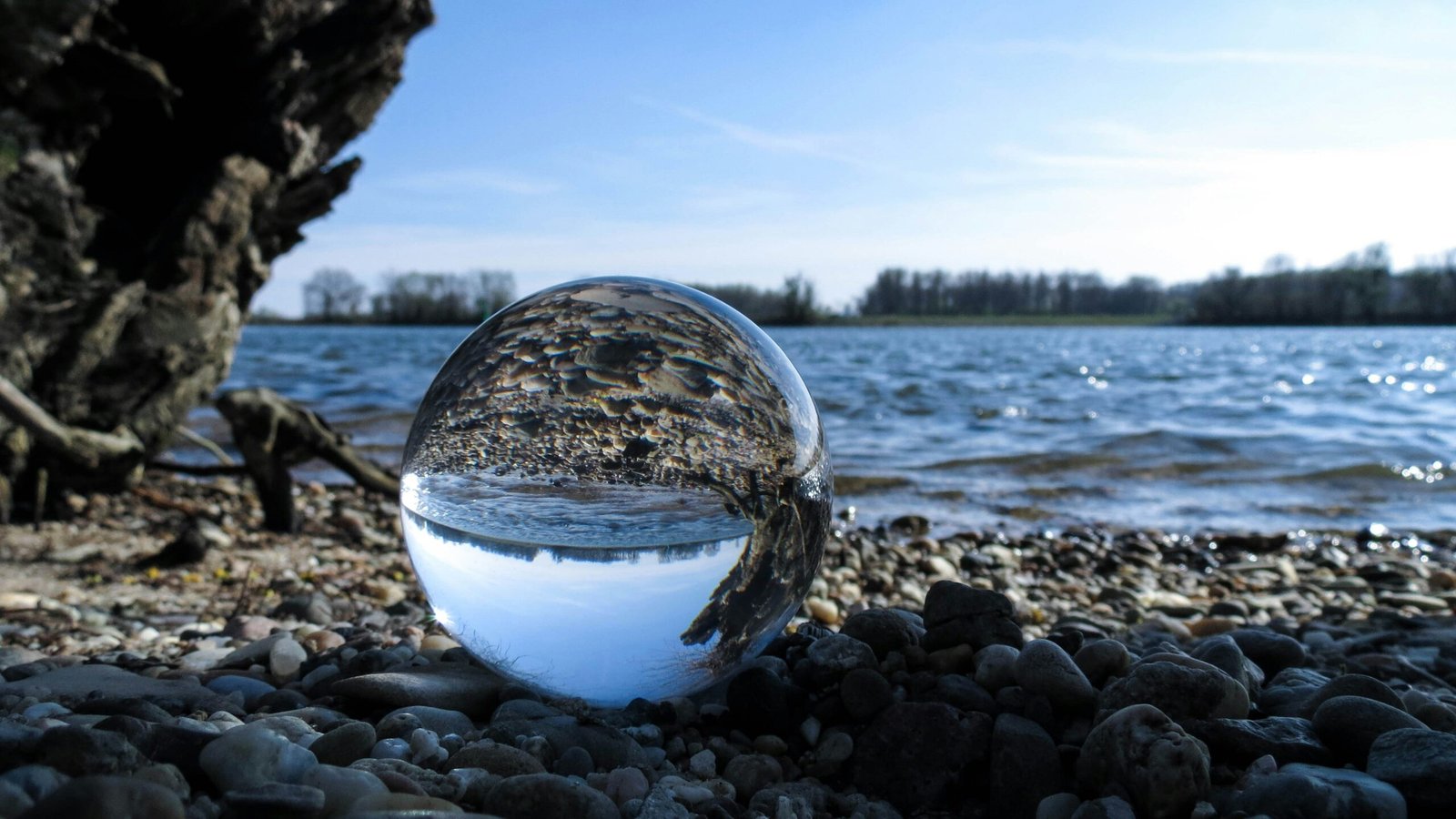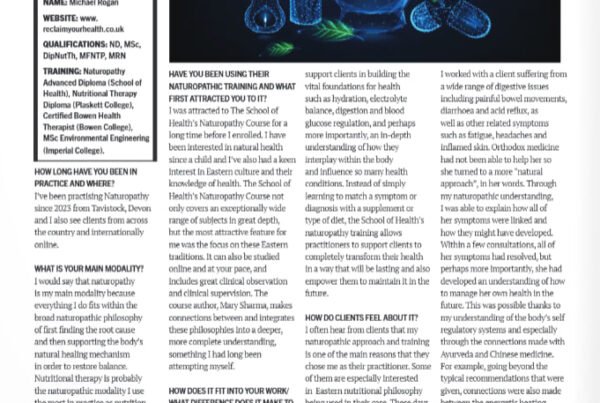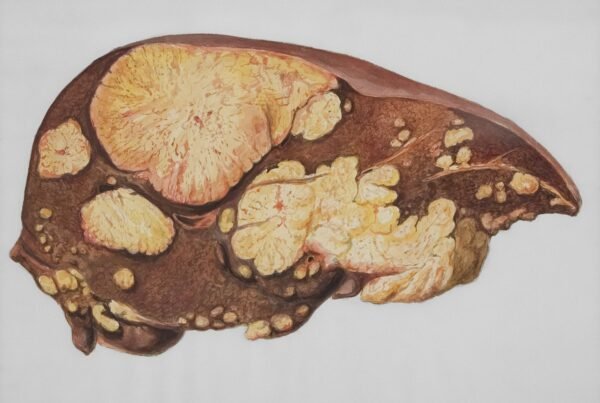Naturopathy as a term describing a philosophy of healing is thought to have first been established by Benedict Lust who purchased the rights from his colleague, Dr John Scheel in the 19th century. Lust was trained by one of the fathers of modern naturopathy, Father Sebastian Kneipp, and he later established the American Naturopathic Association in the United States. We will return to Father Kneipp later. However, the true roots of naturopathy lie in the ancient past and are thus difficult to trace so precisely.
Are you interested in a holistic approach to health and nutrition that incorporates naturopathy? Read about my programs here.
The foundations of naturopathic philosophy lie in the understanding that the body has a natural self-regulation and healing mechanism and that the way back to health (as well as the key to maintaining it) lies in supporting and working with the natural functions of the body so that it can heal itself. This is in contrast to the mainstream medicine of today which generally seeks to eliminate the manifestation of symptoms with pills and surgery (working against, rather than with, the body’s natural healing mechanisms), without addressing the true causes. Until relatively recently, naturopathic understanding was quite universal and therefore the roots of naturopathy can be traced back to all of the ancient traditional medical systems including Ayurveda, Chinese, Tibetan and Unani medicine as well as traditional herbal systems from around the world. Hippocrates, still considered the father of medicine, also taught a naturopathic philosophy and his followers are thought to have been the first to use the term vis medicatrix naturae (the healing power of nature), which is now part of the fundamental understanding of naturopathic philosophy. Hippocrates himself is thought to have studied medicine in Egypt; thus we can trace naturopathy back to ancient knowledge that was not limited by location or culture.
Moving beyond the ancient roots and into more recent developments, the modern roots of naturopathy lie in the development of “water cure”, nowadays known as hydrotherapy. Water has been used to support health for a very long time, but the modern development of this discipline blossomed in Austria in the 18th and 19th century through the practice of Vincent Priessnitz (17991851), who became a very influential figure for German, Austrian, American and British naturopathy. Priessnitz may have been inspired by the work of his compatriot Johann Hahn (1696-1773) who brought the knowledge of hydrotherapy to Germany from the British Sir John Floyer (1649-1734). Followers of hydrotherapy also promoted a healthy diet, lifestyle and exercise alongside the water treatments. Perhaps the most famous and influential of practitioners from this school was Father Sebastian Kneipp (1821-1897) who lived in Bavaria. Suffering ill-health in his youth, he used the healing power of water treatments to strengthen himself enough to join the priesthood and later in his life treated and taught many who would later become influential naturopaths in their own right including Henry Lindlahr, Alex Le Doux and Benedict Lust.
Henry Lindlahr (1862-1924), author of Philosophy of Natural Therapeutics, which remains an influential text today, was an American who travelled to Bavaria to be treated by Father Kneipp. He later returned to the United States in excellent health and begun to teach others according to his philosophy of “Nature Cure”, learnt from Kneipp. The Nature Cure movement was another important root of modern Naturopathy. Lindlahr himself trained many who became influential in the development of Naturopathy including OG Carrol (1879-1962), who at one point was said to be the busiest practitioner of any discipline in the US. OG Carrol was also trained by Alex Le Doux, another one of Kneipp’s student. James Thomson (1887-1960) was another of Lindlahr’s students and he set up Edinburgh School of Natural Therapeutics in 1919 and later the Nature Cure Association in the UK with Stanley Lief (himself a student of Bernarr McFadden, considered the founder of the health and fitness culture in the US). Perhaps the most famous and influential of Lindlahr’s students was Bernard Jensen (1908-2001).
Bernard Jensen originally trained as a chiropractor and later studied nutrition to heal himself before he devoted his life to helping others. He was a student of Lindlahr and also J.H. Kellogg (18521943) and travelled extensively to research how different peoples of the world lived and stayed healthy. He later set up the Hidden Valley Heath Ranch where he treated and taught his patients how to live healthily. Jensen was particularly influential in the development of Iridology (the study of signs in the iris of the eye and their correlations to health) and bowel cleansing. He also trained many people who became influential teachers in their own right including Lawrence Plaskett.
Other important figures in the development of naturopathy include Andrew Taylor Still, who developed the practice of osteopathy in the 19th century. Osteopathy, together with its cousin chiropractic (developed by one of Still’s students, Daniel David Palmer) were extremely influential on naturopathic philosophy and training and remain so to this day.
There are too many people involved in the history of naturopathy to mention them all in this short essay, however further mention should be given to the influence of John Tilden who put forward the theory of toxaemia or autointoxication, which examines the negative impact of toxins in our bowels upon health. Of course, the work of Claude Bernard (1813-1878) and Antoine Bechamp (18161908) must also be mentioned for their contributions to Terrain Theory, our understanding of pleomorphism, the importance of alkalinity, negative charge, nutrition and the elimination of toxins, all of which fit into the greater naturopathic understanding of health and disease developed over the centuries by the great practitioners mentioned above and many others.
In more recent times, naturopathy in the UK has been greatly influenced by the work of Lawrence Plaskett and Barbara Wren. Plaskett had a background in biochemistry but was later attracted to a more holistic approach and trained with Jensen, J.R. Worsley (who brought Five Elements Acupuncture to the UK) and others. He set up the UK’s first school of nutritional medicine in 1982 (where I trained in nutritional therapy). Between them, they trained many practitioners and their teachings and naturopathic philosophy are being preserved and developed today by Mary Sharma at the School of Health in Stroud which is where I trained as a naturopath.
Are you interested in a holistic approach to health and nutrition that incorporates naturopathy? Read about my programs here.
References
Sharma, M, 2019, School of Health Naturopathy Course Notes, Naturopathy Module, The School of Health, Stroud, UK
Plaskett, L, Plaskett International College website, accessed July 2024





